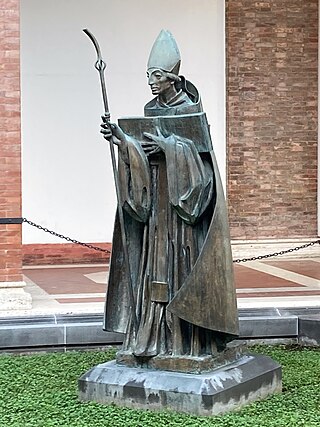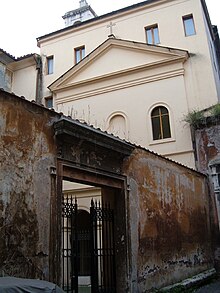
Santa Maria sopra Minerva is one of the major churches of the Order of Preachers in Rome, Italy. The church's name derives from the fact that the first Christian church structure on the site was built directly over the ruins or foundations of a temple dedicated to the Egyptian goddess Isis, which had been erroneously ascribed to the Greco-Roman goddess Minerva.

Sant'Ambrogio e Carlo al Corso is a basilica church in Rome, Italy, facing onto the central part of the Via del Corso. The apse of the church faces across the street, the Mausoleum of Augustus on Via di Ripetta.

The Benedictine Confederation of the Order of Saint Benedict is the international governing body of the Order of Saint Benedict.
The Casa Santa Maria is a residence in Rome, Italy that serves English-speaking priests who are sent by their dioceses for graduate level studies in the city. It is a part of the Pontifical North American College, and served as its main campus from its founding in 1859 until the construction of a new campus on the Janiculum Hill in 1953. It also houses the Bishops' Office for United States Visitors to the Vatican.

Sant'Angelo is the 11th rione of Rome, Italy, located in Municipio I. Often written as rione XI - Sant'Angelo, it has a coat of arms with an angel on a red background, holding a palm branch in its left hand. In another version, the angel holds a sword in its right hand and a scale in its left.

Borgo is the 14th rione of Rome, Italy. It is identified by the initials R. XIV and is included within Municipio I.

The Vallombrosians are a monastic religious order in the Catholic Church. They are named after the location of their motherhouse founded in Vallombrosa, situated 30 km from Florence on the northwest slope of Monte Secchieta in the Pratomagno chain. They use the postnominal abbreviation OSBVall to distinguish themselves from other Benedictines, who generally use the abbreviation OSB.
Domenico Serafini, O.S.B. Subl. was an Italian Cardinal of the Roman Catholic Church who served in various pastoral, diplomatic, and curial posts, and was elevated to the cardinalate in 1914.

Gustav Adolf, Cardinal Prince of Hohenlohe-Schillingfürst, was a member of the Hohenlohe family of Germany, claiming descent from Eberhard, one of the early dukes of Franconia. He became a cardinal of the Catholic Church.

Sant'Anselmo all'Aventino is a complex located on the Piazza Cavalieri di Malta Square on the Aventine Hill in Rome's Ripa rione and overseen by the Benedictine Confederation and the Abbot Primate. The Sant'Anselmo complex, also known as the "Primatial Abbey of Sant'Anselmo" because it is the residence of the Abbot Primate, consists of: an ecclesiastical residential college known as the "College of Sant'Anselmo" ; a university known as the "Pontifical Athenaeum of Saint Anselm" ; the "Church of Sant'Anselmo" ; and the curial headquarters of the "Benedictine Confederation" and Abbot Primate. The complex and associated institutions are named in honor of the Benedictine monk Saint Anselm of Canterbury.

Michelangelo Celesia, O.S.B. Cas. was an Italian Benedictine monk who served as the Archbishop of Palermo from 1871 until his death, and was elevated to the cardinalate in 1884.
Joseph Wilhelm Karl Kleutgen was a German Jesuit theologian and philosopher. He was a member of the Society of Jesus, and contributed significantly to the establishment of Neo-scholasticism.

The Church of Saint Lucy in Selci is an ancient Roman Catholic church, located in Rome, dedicated to Saint Lucy, a 4th-century virgin and martyr.
The Subiaco Cassinese Congregation is an international union of Benedictine houses within the Benedictine Confederation. It developed from the Subiaco Congregation, which was formed in 1867 through the initiative of Dom Pietro Casaretto, O.S.B., as a reform of the way of life of monasteries of the Cassinese Congregation, formed in 1408, toward a stricter contemplative observance, and received final approval in 1872 by Pope Pius IX. After discussions between the two congregations at the start of the 21st century, approval was given by Pope Benedict XVI in 2013 for the incorporation of the Cassinese Congregation into its offshoot, the Subiaco Congregation. The expanded congregation was given this new name.

Ambrose Agius, O.S.B. was a Maltese Archbishop of the Catholic Church.
Hubert Wolf is a German church historian and professor at the University of Münster. He was awarded a Gottfried Wilhelm Leibniz Prize in 2003. In 2006 he was awarded the Gutenberg Prize of the International Gutenberg Society and the City of Mainz.

Princess Katharina Wilhelmine Maria Josepha of Hohenlohe-Waldenburg-Schillingsfürst was a member of the House of Hohenlohe-Waldenburg-Schillingsfürst by birth and a member of the House of Hohenzollern-Sigmaringen and Princess consort of Hohenzollern-Sigmaringen by marriage.
Tommaso Riccardi, OSB was an Italian Catholic priest and Benedictine monk of the Cassinese Congregation. His monastic name was Placido. He was beatified in 1954.

Saint Ambrose is a small church which is an annex to the farmhouse that takes its name from it, in Brugherio, Italy.

Cascina Sant'Ambrogio is the oldest among the farmhouses in Brugherio, Italy. It is annexed to Saint Ambrose Church from which it takes its name.















